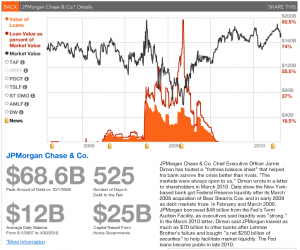 When Steven Rattner published this piece on the GM IPO in HuffPo, he had not yet been sued by NY’s Attorney General for allegedly being “willing to do whatever it took to get his hands on pension fund money including paying kickbacks, orchestrating a movie deal, and funneling campaign contributions,” nor had he yet settled–with no admission of guilt–the SEC investigation that alleges he, “delivered special favors and conducted sham transactions that corrupted the Retirement Fund’s investment process.” Thus, it would go too far to call the Steven Rattner that published that piece a fraudster, or even an alleged fraudster.
When Steven Rattner published this piece on the GM IPO in HuffPo, he had not yet been sued by NY’s Attorney General for allegedly being “willing to do whatever it took to get his hands on pension fund money including paying kickbacks, orchestrating a movie deal, and funneling campaign contributions,” nor had he yet settled–with no admission of guilt–the SEC investigation that alleges he, “delivered special favors and conducted sham transactions that corrupted the Retirement Fund’s investment process.” Thus, it would go too far to call the Steven Rattner that published that piece a fraudster, or even an alleged fraudster.
But a big part of this victory lap is fraudulent.
A key part of Rattner’s argument is that by fixing management issues, Team Auto dramatically altered GM’s value.
A fashionable bit of revisionist history maintains that former GM chief executive Richard Wagoner should not have been fired, especially by a bunch of Wall Street guys turned government bureaucrats. Yet, Ford — which not only avoided bankruptcy but will achieve record profits this year — faced exactly the same challenges as GM: the same United Auto Workers, the same competition from Asian transplants, the same oscillating gasoline prices and the same credit crisis. Why did the two automakers end up on such different paths? Management.
Now, I don’t much agonize over Rattner’s decision to fire Wagoner. I absolutely support the idea of firing CEOs whose companies have to be bailed out. Hell, I even agree that Wagoner’s firing is probably a key part of getting the banksters to trust GM again. But I recognize–as Rattner doesn’t–that Wagoner had started along the same path that Ford’s Alan Mulally had, only about a year and a half behind Mulally, meaning those efforts were more directly affected by the disaster caused by Rattner’s buddies on Wall Street. But on balance, I’m perfectly happy with Rattner’s decision to fire Wagoner.
What I’m not fine with, though, is Rattner’s attack on Wagoner in the same piece he takes credit for two or three business decisions that Wagoner made. Wagoner indubitably presided over GM’s emphasis on China and Brazil, which Rattner calls “enormously successful.”
He likewise oversaw–with Bob Lutz–the development of the GM products now experiencing success in the marketplace, particularly the Malibu, Equinox, and Camaro, which rolled out just as the government came in (the interim team shares credit for the Cruze and Volt).
Its products, while vastly improved in recent years, still do not match those of Ford and its non-U.S. competitors.
[snip]
And at 15 million, General Motors — with its improved products, tighter management, lower cost structure and better balance sheet — will be gushing profits.
And by negotiating VEBA, Wagoner also had a significant role in setting up the conditions that enabled Team Auto to take retiree health care off GM’s books, a big part of the structural costs Rattner takes credit for.
At least $8 billion of annual structural costs sliced from the company’s bleeding North American operations.
If you want to pump up GM’s IPO price based significantly on its improved product quality and its success in China and Brazil, then you cannot at the same time make the firing of Rick Wagoner a central part of your argument for the value of the company. Either Wagoner did a good job on market and product issues, in which case Rattner’s friends are justified to stress improved product quality and great growth potential in China and Brazil, or Wagoner was a complete failure, in which case the folks pushing this IPO are pushing shit. (I believe GM has a great deal of value, though wouldn’t presume to describe its the fair market value of its stock.)
And if all of that doesn’t lead you to question Rattner’s motives and credibility here, check out whom he designates as the appropriate person to pick stocks.
I’ll leave the stock picking to Jim Cramer while observing that GM’s IPO was priced at a discount to Ford’s trading multiple. That’s understandable, given the uncertainties around GM. At the same time, proving itself to Wall Street and closing that multiple gap remains a source of upside for the newly public automaker.
Jim Cramer, famous above all for pumping up stocks with his overheated bluster.
Look, I’m all in favor of Rattner having the benefit of the doubt as he defends himself against charges of fraud. I’m thrilled that GM had a successful stock offering today, even if I’m cautious about what it means. But I’m not in favor of pumping up the stock price of GM based on a specious argument claiming credit for things Rick Wagoner did, even while pointing to Wagoner’s firing as a key part of GM’s value proposition.




